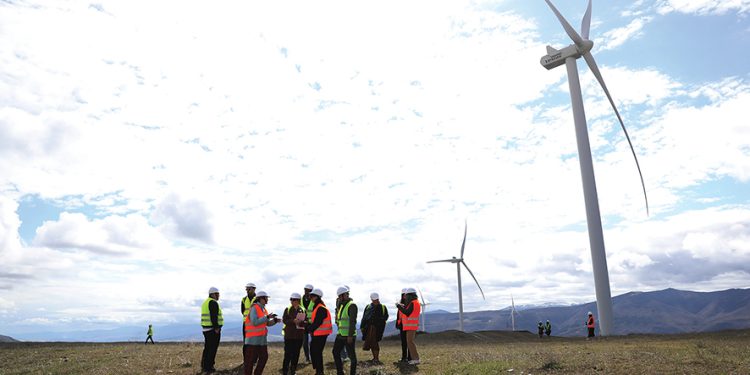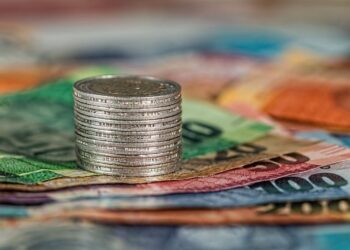At the beginning of April, the Asian Development Bank (ADB) held a media tour for Georgia-based journalists ahead of the ADB Annual Meeting to be held in Tbilisi on 2-5 May 2024.
Since 2007, ADB has supported Georgia through sovereign and private sector investments, policy reforms, capacity building, and knowledge. This is helping Georgia achieve sustainable development, transition to a green and integrated economy, foster a more resilient and inclusive society, and develop into a regional trade and logistics gateway.
ADB is one of Georgia’s largest multilateral development partners. As of 31 December 2023, ADB had committed 86 public sector loans, grants, and technical assistance to Georgia, totaling $4 billion.
“Our portfolio is divided roughly 50-50 between our sovereign operations – working with the government, and our private sector operations,” Lesley Bearman Lahm, Country Director of the ADB Georgia Resident Mission, tells us. “Our overarching objective is to support Georgia’s transition and trajectory and continued progress towards a green and integrated economy that supports a resilient and inclusive society, and the projects we will see on this media tour work towards achieving these objectives: Projects that improve connectivity, improve the quality of life in cities and rural areas, open up economic opportunities, as well as help the private sector go green.”
“Georgia has one of the most dynamic private sectors in the region, and is in a unique position between Europe and Asia,” David Urbaneja-Furelos, Unit Head, ADB Private Sector Operations, notes. “ADB is ramping up operations to cover multiple sectors– energy, water utilities, transport, telecoms, agribusiness and health and education. ADB is considered the ‘climate bank’ for Asia and the Pacific. The projects we implement are primarily transactions that are climate-focused, or geared towards capital market development: Putting together our sovereign operations with a capital market development strategy with the Government of Georgia, and helping issuers to access them.”
Investing in ‘Georgia Capital’ to Support Renewable Energy, Education, and Corporate Sustainability
In August 2023, ADB and JSC Georgia Capital (GCAP) partnered to issue GCAP’s inaugural sustainability-linked bond. ADB agreed to invest $16 million, with the proceeds earmarked for refinancing renewable energy and education investments, and for financing corporate measures to achieve the group’s sustainability-linked key performance indicator.
GCAP is one of the largest private investment companies in Georgia, with investments in banking and insurance, healthcare, renewable energy, water utility services, education, and housing and hospitality.
“Until four-five years ago, capital markets in Georgia were very limited, with a maximum size of 20-25 million. We were the first in the country to issue the largest bond at that time, and the first listed in the stock exchange in terms of a green bond,” said Giorgi Alpaidze, CFO at Georgia Capital.
“We’re very proud to have, in Georgia, a lot of ‘first of a kind’ transactions,” Urbaneja-Furelos says. “It is really helping Georgia, despite the small size of the economy, to have a real niche, and to show that, together with the help of the government, IFIs and private sector players, Georgia really is on a different path, something also shown in December when Georgia was granted EU candidate status.”
Investment in Tegeta Green Bond to Expand Electric Vehicles and Charging Networks in Georgia
In July 2023, ADB invested 20 million lari (around $7.6 million) in Tegeta Motors’ inaugural 2-year and 6-month Lari-denominated green bond, the first-ever such issuance on the Georgian Stock Exchange.
The proceeds financed the deployment of zero-emission light, road, and non-road electric vehicles, and an expansion of Georgia’s EV charging network by 70 new stations.
Tegeta is a Georgian automotive company with over 400,000 registered retail, 40,000 corporate-, and 3,000 wholesaler clients through 28 service centers across the country.
“Tegeta is dedicated to pioneering the issuance of Lari-denominated green bonds to support Georgia’s efforts to reduce greenhouse gas emissions and transition toward a more sustainable transport sector,” Tegeta Executive Director Vakhtang Kacharava said at the time. “This issuance reaffirms our commitment to environmental responsibility and sustainability, and actively contributes toward a climate-friendly future.
“The more the economy develops, the more exchange rate fluctuations bring risks to our portfolios, so we really need to diversify them, and thus we encourage domestic capital market development,” says Ekaterine Guntsadze, Georgian Deputy Minister of Finance. “Hearing from the private sector that domestic borrowing and green loans are already in practice brings a lot of motivation and shows progress in private sector development. It is always welcome when the private sector takes over sovereign portfolios, when we see the projects being built through the support we are getting from the IFIs, and the expertise those projects bring and the money it puts into the country’s budget – this is why we are trying to have the fiscal space available so that we can borrow for such projects.”
Investment in Georgian Renewable Power Operations (GRPO) green bond
In October 2022, ADB invested $4 million in a green bond issued by Georgian Renewable Power Operations (GRPO), which is using the funds to support its ongoing operations.
GRPO operates five renewable power projects, including four hydropower plants with a total installed capacity of 50.4 megawatts and Georgia’s only wind power plant.
ADB’s investment forms part of an $80 million issue by GRPO of a 5-year green bond, Georgia’s first domestically-listed green bond and the largest bond listed on the Georgian Stock Exchange. ADB will also administer a $4 million subscription to the bond by Leading Asia’s Private Infrastructure Fund.
“In 2022, we made an exceptional transaction, a bond we issued on the local capital market, one which was the first ever green bond in Georgia, the largest corporate transaction of the time,” Nuka Mshvidobadze, Georgian Renewable Power Operations (GRPO) CFO, tells GEORGIA TODAY. “It resulted in unprecedented interest from international investors. We have four international institutions present in our obligations – FMO, IFC, EBRD and ADB. ADB acted as an anchor in this transaction, and without their long-term trust and support, it would have been very hard to make it work. ADB’s presence in the country and growing office means they see things differently and already have very good knowledge of the local laws and development issues. This boosts us in our development, in our environmental and social, governance, finance and technical standards. When they are by our side, we know we’re working to a high level,” she adds.
Mshvidobadze informs us that Georgia has 1000-1500 MW in capacity for windfarms to be built, and a current 30% deficit, though there is great future potential to make up this deficit through both wind and hydro plants.
“Georgia can be self-sufficient. It would certainly be good for Georgia in terms of energy security,” she says. “Right now, we are increasing imports of electricity and gas from Azerbaijan and Russia. Georgia can be an energy hub. It has amazing potential in renewable energy, and if we build the Black Sea cable, we can be exporters rather than importers.”

As to the social concerns, among them hyped-up fears of villages being flooded for the sake of hydro plants and money put in administrative pockets, Mshvidobadze says it often comes down to miscommunication and lack of education.
“Since the early 1990s, there has been huge protest against large HPPs with reservoirs, leading to the building of HPPs in Georgia being blocked. Yet some HPPs don’t require reservoirs. Awareness needs to be increased, right from school age,” she says. “We [GRPO] are among the few developers to have built a Run-of-the-River HPP in Svaneti – a tough region to build in. With the right provision of information to the local population, and through sponsoring an annual ski tournament, we are welcomed there.”
“They also need to understand the alternative,” Urbaneja-Furelos puts in. “Do you, as a person, want to rely on other countries for your energy supply? Do you want to have more pollution in your country? They need to understand the tradeoffs.”
“Energy independence is personal to all of us in the field,” Mshvidobadze says. “We understand how much we need renewable energy. It’s a pity that the pace of growth is slower than it could be. We could export, generate energy as an economical resource. Not every country can say it’s so lucky.”
Looking ahead, Mshvidobadze tell us there is a 320 MW medium-sized HPP in Svaneti in the pipeline, and two more windfarms – one in Kaspi, the other nearer Tbilisi, with a current estimated completion date of 2026-27.
The Gori windfarm has 6 turbines, 3.4 MW each, 20.6 MW circa installed capacity in total. This, at full capacity, provides electricity to around 50,000 households via the national grid.
The Gori turbines boast a 119m blade diameter and are 90m tall. The new projects will have bigger turbines: A 150-170m blade diameter and height of 100-120m, which means each farm will be able to generate up to 80 MW.
Major issues in constructing the Gori wind farm were logistical: Transporting the blades from Poti port to the site. The bottlenecks of the old Rikoti road meant they had to be brought via Chiatura. The new East-West Highway construction, once complete, will ease delivery of the bigger blades to the new sites.
Another note we were happy to hear from GRPO was that, within the framework of ADB, there is an ongoing gender awareness campaign to have more females choose the energy sphere for their future careers.
“I have personally gone to several schools presenting the career opportunities in the energy field,” Mshvidobadze tells us. “We have only around 20% share of female workers in the field. I’m the only woman on the management board! I explain to these high school graduates why the energy sector is important, why we need to work towards self-sufficiency. It’s an exciting ever-evolving sector to be in.”
Improving Urban Services, Water Supply and Sanitation Services in Georgian Towns
Since 2011, ADB’s urban services investment program has been improving water supply and sanitation services in 13 cities of Georgia.
ADB has helped provide 24-hour water supply in the Georgian towns of Abasha, Anaklia, Poti, Ureki, Mestia, Jvari, Chiatura, Kutaisi, Zugdidi and Telavi.
Works are ongoing in Gudauri, Marneuli and Bolnisi. The project in these towns included constructing a full circle of infrastructure, including reservoirs, transmission mains, water networks, as well as sewage networks and wastewater treatment plants. Works are ongoing in Poti on a wastewater system and treatment plant.
On driving through a typical street in Kutaisi, and indeed, throughout much of Georgia beyond the boundaries of the capital Tbilisi, you will see the bright blue plastic or rusted metal of the population’s family water tanks, often atop towers, peeking out above garden walls. These date from a time when drinking water was in rare supply, and one had to fill up the tank in those quick few hours of supply each day or two. Many of these tanks, at least in the cities touched by the ADB project, today stand empty – as the government, with the financial support of ADB, has set up a water supply that is (almost always) 24/7, so the tanks are no longer needed.
As part of the media tour, we were taken to two of Kutaisi’s underground reservoirs.
“Water is pulled up via pumps to the first reservoir, where it undergoes chlorination. It then goes into the distribution network and holding reservoirs or tanks, and from there, is gravity-fed to supply the whole city of Kutaisi,” Murman Katsitadze, Kutaisi Water Project Officer, ADB, explains.
“In the past, there was a water supply system, but it was in very poor condition. The city had from four to six hours of water supply a day, and in regular cases, not even that, and not every day. Now, the same amount of electricity is consumed, but we have 24/7 supply for the whole city, with the same expenditure.”
He says that, over time, they are replacing the old soviet pumps with a modern German brand. It takes time and money, and the system is not yet perfect – but supply is guaranteed to Kutaisi citizens for up to 10 hours even without all the pumps in operation, thanks to the massive holding reservoirs.
“They say Georgia is abundant in water, but the reality is that we need to take care of our supply. For example, here, we see the impact of climate change on the water levels, reducing supply over time,” says Mzia Giorgobiani, Deputy Minister of Regional Development and Infrastructure, highlighting a global issue affecting Georgia’s water system subscribers.
“Ultimately, we want to connect the villages around Kutaisi to these reservoirs too, and, indeed, by 2030 we want to have clean water supply systems countrywide and meters in every household,” she notes. “It takes time to prepare a project for construction. We are also challenged in finding among Georgian companies those with the needed level of experience and expertise to undertake such projects. As such, we currently need to bring in internationals, though the subcontractors are Georgian, meaning local knowledge is growing. This is all undertaken thanks to IFI financing, financing from local investment banks, the German Development Bank with EU support, from ADB, these being just a few examples. Nearly half the financing for the water company comes from the state budget, helping municipalities to cover the costs and step by step expand the system.”
Giorgobiani says that they have made changes to the policy law regarding development of the water supply system, have increased the workers’ salaries, and want to create water testing laboratories in every region.
“Sanitation is also key, and the impact on the environment of waste,” she adds. “Until 2012, we had no modern, centralized sanitary treatment plant, and this is something we also want to expand. Zugdidi is one example of a successfully completed project. We are in the final stage of hiring a contractor to install such a plant in Kutaisi, financed by Western donors. We also want to increase the amount from the budget dedicated to clean water supply, and this will become much more realistic once the East-West Highway is completed.”
About ADB
ADB is committed to achieving a prosperous, inclusive, resilient, and sustainable Asia and the Pacific, while sustaining its efforts to eradicate extreme poverty. Established in 1966, it has 68 members—49 from the region.
In 2023, ADB committed $23.6 billion in loans, grants, equity investments, guarantees, private sector programs, and technical assistance to both the public and private sectors of its borrowing members. ADB bolstered its total support with cofinancing of $16.4 billion.














